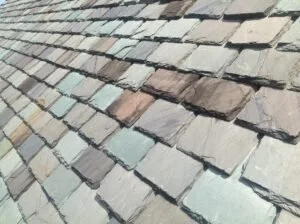What You Need to Know About Slate Roof Colors
Multi Colored Slate Roof
Slate color variation is completely natural—and part of what gives slate roofing its distinctive beauty and timeless appeal. Because slate is a natural stone product, it’s quarried from various geological formations, then processed into roofing tiles of different sizes, thicknesses, and performance grades. Quality slates must meet the ASTM C406 S1 rating, which confirms their density, strength, and durability.
Understanding Slate Color Terminology
Slate is available in a wide array of natural colors—blues, greens, purples, blacks, grays, and even mixed shades. However, there are important distinctions in how these colors behave over time.
While slate itself doesn’t “fade” in the way painted surfaces do, terms like “fading,” “non-fading,” and “unfading” are commonly used within the slate industry to describe how slate appearance may change based on mineral content and exposure.
Non-fading or unfading slate retains its original color for decades or even centuries.
Fading slate may develop a light chalky film or color shift over time due to the natural release of calcium or iron minerals. This can make the surface appear lighter or “weathered.”
These terms are especially relevant when dealing with black slates quarried from areas like Pennsylvania and Virginia, where some varieties are prone to surface efflorescence (the white, chalky residue you may see).
The idea isn’t that fading slate is defective—but that buyers should be aware of what kind of visual changes to expect. Non-fading slates typically have a longer structural life because they don’t lose surface material from mineral washout.
Weathering Classifications
Slate is also classified by how much its color is expected to change over time, using the terms non-weathering, semi-weathering, and weathering:
Non-weathering slate: Maintains its original color with minimal change.
Semi-weathering slate: Some pieces will change color slightly, while others remain the same. This creates a subtle, blended appearance over time.
Weathering slate: Most pieces will develop warm earth tones—like tan, buff, or brown—as a result of natural oxidation. This doesn’t affect the lifespan, just the color palette.
These changes are purely cosmetic and do not reduce the life expectancy of the slate. In fact, many homeowners and architects appreciate the patina that develops over time, giving the roof depth and character.
Matching Slate to Architectural Styles
Choosing the right slate color can also help complement your home's architecture:
Black or gray slate suits classic or Gothic Revival styles.
Purple or green slate pairs beautifully with Victorian or Queen Anne homes.
Multicolored or semi-weathering slate is popular on Rustic, Tudor, and Arts & Crafts-style homes, where natural variation is part of the charm.
Where the Slate Comes From
Different quarries produce distinct colors based on regional mineral deposits. For example:
Vermont quarries are known for multicolored and green slates.
New York produces rich purples and grays.
Virginia and Pennsylvania black slates are dense and strong, but may be prone to weathering, depending on the exact source.
Premium slates are often imported from Spain or Canada, where certain colors are more available.
If you ever need to replace broken or missing slate, knowing the original quarry or color classification is important to ensure a proper match. Our team sources matching slate from trusted quarries and suppliers across the U.S. and internationally to maintain historical accuracy and visual consistency.
Final Thoughts
Choosing the right slate roof color is about more than just appearance—it involves understanding how the stone will age, weather, and perform. Whether you're looking for a consistent, sharp look or a roof that will develop a warm patina over time, there's a slate out there to fit your vision.
For help selecting or matching slate colors for your home or restoration project, reach out to our team at Carolina Slate—we specialize in authentic slate roofing that respects both tradition and performance.

